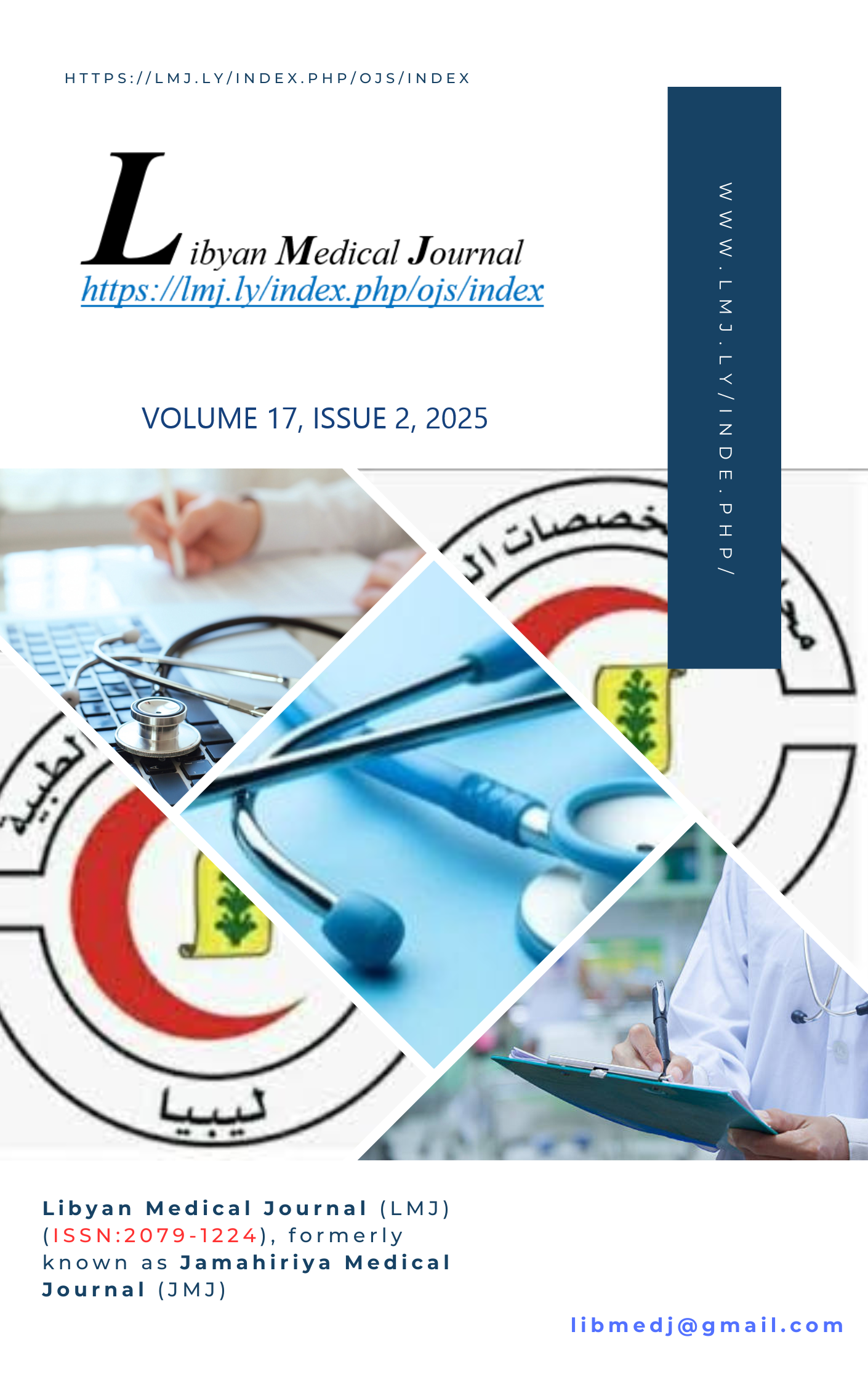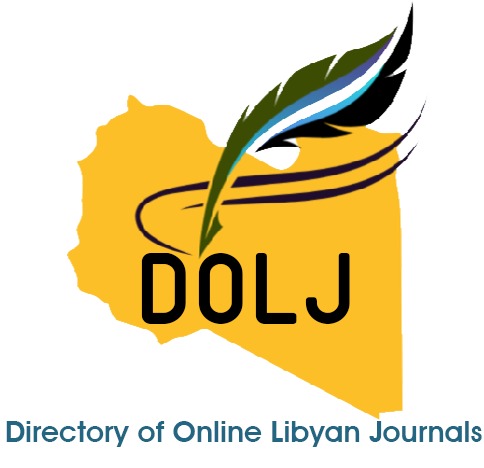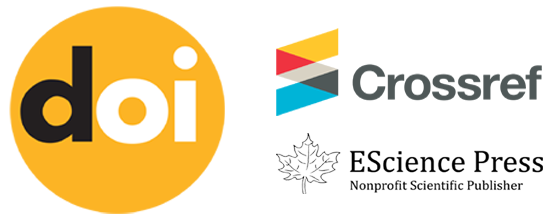Insulin Pump Therapy in Libya: A Comparative Study on Glycemic Control and Patient Outcomes in Type 1 Diabetes
DOI:
https://doi.org/10.69667/lmj.2517209Keywords:
Type 1 diabetes mellitus, Insulin pump therapy, CSII, HbA1C, Hypoglycemia, Diabetic ketoacidosis, LibyaAbstract
This study evaluated the clinical effectiveness of continuous subcutaneous insulin infusion (CSII) versus multiple daily injections (MDI) in managing type 1 diabetes mellitus (T1DM) among Libyan patients. Conducted in June 2022, the comparative cross-sectional study compared 32 CSII users (≥6 months therapy) with 30 MDI controls through structured questionnaires. The CSII group demonstrated significantly better outcomes, including superior glycemic control (mean HbA1c 6.97±0.61 vs 9.8±1.99), reduced acute complications (hypoglycemia: 31.3% vs 50%; DKA: 3.1% vs 20%), and higher treatment adherence (81.3% vs 43.3%). Glycemic improvement correlated strongly with pump duration, showing progressive HbA1c reduction from 7.2±0.2 at 6-12 months to 6.89±0.16 after >2 years of use. The CSII cohort also exhibited more favorable BMI distributions (78.1% healthy weight vs 33.3%) and reported enhanced quality of life. Despite these benefits, challenges in maintenance supply availability were reported. These findings provide compelling evidence for CSII's clinical superiority in Libya's context and support its wider implementation through national programs that address current supply chain limitations while ensuring proper patient training and follow-up support. The results highlight CSII as a valuable therapeutic advancement for T1DM management in resource-constrained settings
References
Elbaruni K, Abdulwahed E, Khalfalla W, Alsudany R, Jerbi R, Alwaseea N, et al. Association Between Some Inflammatory Markers and HbA1c in Patients with Type 2 Diabetes Mellitus. AlQalam Journal of Medical and Applied Sciences. 2023 Mar 31:137-41.
Hu FB. Globalization of diabetes: the role of diet, lifestyle, and genes. Diabetes Care. 2011;34(6):1249-57.
Elmehdawi RR, Ehtuish EF, Elmehdawi RM, Swalem A, Abusaa A, Almahdi H, et al. Prevalence of diabetes mellitus in Libya: a national study. Libyan J Med. 2013;8:20616.
Al-Moosa S, Allin S, Jemiai N, Al-Lawati J, Mossialos E. Diabetes epidemic in the Middle East: a systematic review. J Diabetes Res. 2020;2020:1-12.
Pickup JC, Sutton AJ. Severe hypoglycaemia and glycemic control in type 1 diabetes: meta-analysis of multiple daily insulin injections versus continuous subcutaneous insulin infusion. Diabet Med. 2008;25(7):765-74.
Misso ML, Egberts KJ, Page M, O'Connor D, Shaw J. Continuous subcutaneous insulin infusion (CSII) versus multiple insulin injections for type 1 diabetes mellitus. Cochrane Database Syst Rev. 2010;(1):CD005103.
Badi A, Elzouki A, Abudher A, Elmehdawi R. First Libyan experience with insulin pump therapy: impact on glycemic control and patient satisfaction. Libyan J Med Sci. 2015;2(1):12-8.
American Diabetes Association. Standards of medical care in diabetes-2020 abridged for primary care providers. Clin Diabetes. 2020;38(1):10-38.
Yeh HC, Brown TT, Maruthur N, Ranasinghe P, Berger Z, Suh YD, et al. Comparative effectiveness and safety of methods of insulin delivery and glucose monitoring for diabetes mellitus: a systematic review and meta-analysis. Ann Intern Med. 2012;157(5):336-47.
Danne T, Nimri R, Battelino T, Bergenstal RM, Close KL, DeVries JH, et al. International consensus on use of continuous glucose monitoring. Diabetes Care. 2017;40(12):1631-40.
World Health Organization. Global report on diabetes. Geneva: WHO; 2023.
International Diabetes Federation. IDF Diabetes Atlas. 10th ed. Brussels: IDF; 2022.
Bergenstal RM, Tamborlane WV, Ahmann A, Buse JB, Dailey G, Davis SN, et al. Effectiveness of sensor-augmented insulin-pump therapy in type 1 diabetes. N Engl J Med. 2010;363(4):311-20.
Battelino T, Conget I, Olsen B, Schütz-Fuhrmann I, Hommel E, Hoogma R, et al. The use and efficacy of continuous glucose monitoring in type 1 diabetes treated with insulin pump therapy: a randomised controlled trial. Diabetologia. 2012;55(12):3155-62.
Maahs DM, Hermann JM, Holman N, Foster NC, Kapellen TM, Allgrove J, et al. Rates of diabetic ketoacidosis: international comparison with 49,859 pediatric patients with type 1 diabetes from England, Wales, the U.S., Austria, and Germany. Diabetes Care. 2015;38(10):1876-82.
Peyrot M, Rubin RR, Kruger DF, Travis LB. Correlates of insulin injection omission. Diabetes Care. 2010;33(2):240-5.
Rubin RR, Peyrot M, STAR 3 Study Group. Health-related quality of life and treatment satisfaction in the Sensor-Augmented Pump Therapy for A1C Reduction 3 (STAR 3) trial. Diabetes Technol Ther. 2012;14(2):143-51.
Hoogma RP, Hammond PJ, Gomis R, Kerr D, Bruttomesso D, Bouter KP, et al. Comparison of the effects of continuous subcutaneous insulin infusion (CSII) and NPH-based multiple daily insulin injections (MDI) on glycaemic control and quality of life: results of the 5-nations trial. Diabet Med. 2006;23(2):141-7.
Al-Lawati JA. Diabetes mellitus: a local and global public health emergency! Oman Med J. 2017;32(3):177-9.
Deeb A, Al Qahtani N, Akle M, Singh H, Assadi R, Attia S, et al. Insulin pump therapy satisfaction in Arab adolescents with type 1 diabetes. Diabetes Technol Ther. 2019;21(7):391-7.











